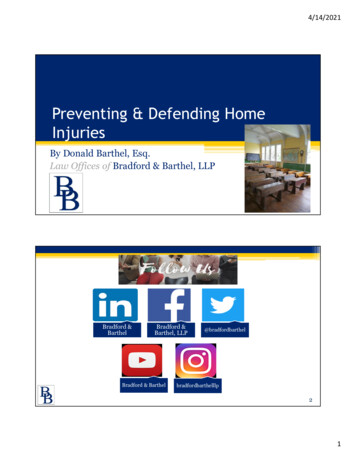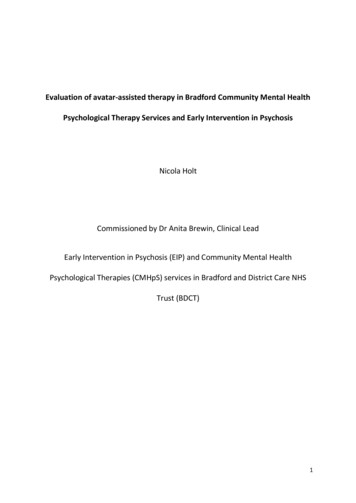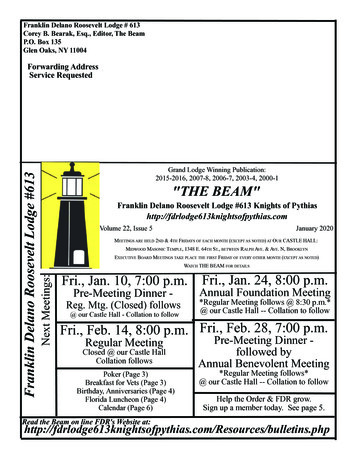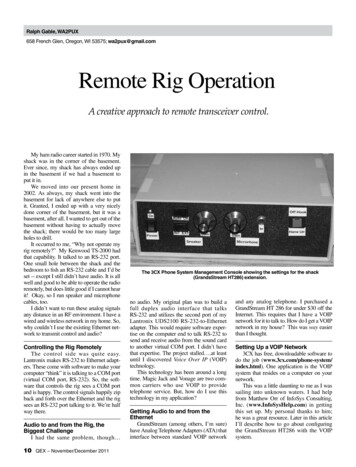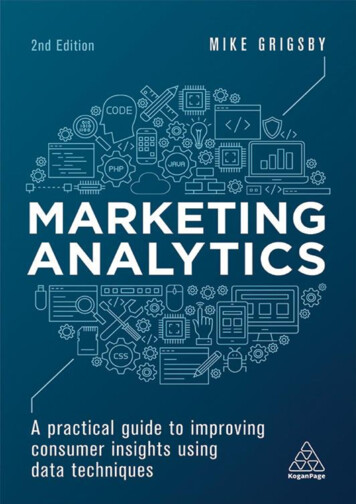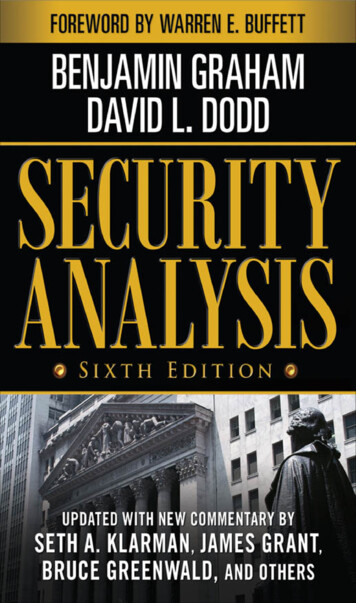
Transcription
PRAISE FOR THE SIXTH EDITION OF SECURITY ANALYSIS“The sixth edition of the iconic Security Analysis disproves the adage ‘’tisbest to leave well enough alone.’ An extraordinary team of commentators,led by Seth Klarman and James Grant, bridge the gap between the simpler financial world of the 1930s and the more complex investment arenaof the new millennium. Readers benefit from the experience and wisdomof some of the financial world’s finest practitioners and best informedmarket observers. The new edition of Security Analysis belongs in thelibrary of every serious student of finance.”David F. SwensenChief Investment OfficerYale Universityauthor of Pioneering Portfolio Managementand Unconventional Success“The best of the past made current by the best of the present. Tiger Woodsupdates Ben Hogan. It has to be good for your game.”Jack MeyerManaging Partner and CEOConvexity Capital“Security Analysis, a 1940 classic updated by some of the greatest financialminds of our generation, is more essential than ever as a learning tooland reference book for disciplined investors today.”Jamie DimonChairman and CEOJPMorgan Chase
“While Coca-Cola found it couldn’t improve on a time-tested classic, SethKlarman, Jim Grant, Bruce Greenwald, et al., prove that a great book canbe made even better. Seth Klarman’s preface should be required readingfor all investors, and collectively, the contributing editors’ updates makefor a classic in their own right. The enduring lesson is that an understanding of human behavior is a critical part of the process of security analysis.”Brian C. RogersChairmanT. Rowe Price Group“A classic has now been updated by some of the greatest and mostthoughtful investors of our time. The book was a must read and has nowbeen elevated to a new level.”Daniel S. OchSenior Managing MemberOch-Ziff Capital Management Group“Readers will find the updated version of Graham and Dodd’s SecurityAnalysis to be much improved from earlier editions. While the timelessadvice from two of the greatest value investors continues to resonate, theessays that are contributed by some of the world’s top value investors addimmeasurably to the read. These investors practice what they preach intheir essays and combine to make this edition the best ever! I highly recommend this volume to all investors—old and young—who will benefitfrom the tried and true principles of the past and the updated applications to today’s turbulent markets!”Morris SmithPrivate InvestorFormer ManagerFidelity Magellan Fund
“No book empowers you with better tools for intelligent investing thanSecurity Analysis. Seth Klarman and his fabulous team have produced anonpareil edition of Ben Graham’s classic for the new millennium.”Mason HawkinsChairman, Longleaf PartnersSoutheastern Asset Management“The ideas of Graham and Dodd have withstood all kinds of market conditions and 75 years of scrutiny—making them ever more relevant formodern-day investing. The essays by Klarman and other storied valueinvestors lucidly illustrate that while the capital markets landscape maybe vastly changed from years past, basic investor traits are not, and disciplined application of the principles of Security Analysis continues to provide an important edge in investing.”André F. PeroldGeorge Gund Professor of Finance and BankingHarvard Business School
This page intentionally left blank
SECURITY ANALYSIS
SECURITY ANALYSIS PRIOR EDITIONSGraham and Dodd: Security Analysis, First Edition (1934)Graham and Dodd: Security Analysis, Second Edition (1940)Graham and Dodd: Security Analysis, Third Edition (1951)Graham, Dodd, Cottle, and Tatham: Security Analysis, FourthEdition (1962)Graham, Dodd, Cottle, Murray, Block, & Leibowitz: SecurityAnalysis, Fifth Edition (1988)
SECURITY ANALYSISPrinciples and TechniqueBENJAMIN GRAHAMInvestment Fund Manager;Lecturer in FinanceColumbia UniversityANDDAVID L. DODDAssociate Professor of FinanceColumbia UniversitySixth EditionNew York Chicago San Francisco Lisbon London MadridMexico City Milan New Delhi San Juan SeoulSingapore Sydney Toronto
Copyright 2009, 1988, 1962, 1951, 1940, 1934 by The McGraw-Hill Companies, Inc. All rightsreserved. Manufactured in the United States of America. Except as permitted under the UnitedStates Copyright Act of 1976, no part of this publication may be reproduced or distributed in anyform or by any means, or stored in a database or retrieval system, without the prior writtenpermission of the publisher.0-07-164293-5The material in this eBook also appears in the print version of this title: 0-07-159253-9.All trademarks are trademarks of their respective owners. Rather than put a trademark symbol afterevery occurrence of a trademarked name, we use names in an editorial fashion only, and to thebenefit of the trademark owner, with no intention of infringement of the trademark. Where suchdesignations appear in this book, they have been printed with initial caps.McGraw-Hill eBooks are available at special quantity discounts to use as premiums and salespromotions, or for use in corporate training programs. For more information, please contact GeorgeHoare, Special Sales, at george hoare@mcgraw-hill.com or (212) 904-4069.TERMS OF USEThis is a copyrighted work and The McGraw-Hill Companies, Inc. (“McGraw-Hill”) and its licensors reserve all rights in and to the work. Use of this work is subject to these terms. Except as permitted under the Copyright Act of 1976 and the right to store and retrieve one copy of the work,you may not decompile, disassemble, reverse engineer, reproduce, modify, create derivative worksbased upon, transmit, distribute, disseminate, sell, publish or sublicense the work or any part of itwithout McGraw-Hill’s prior consent. You may use the work for your own noncommercial and personal use; any other use of the work is strictly prohibited. Your right to use the work may be terminated if you fail to comply with these terms.THE WORK IS PROVIDED “AS IS.” McGRAW-HILL AND ITS LICENSORS MAKE NOGUARANTEES OR WARRANTIES AS TO THE ACCURACY, ADEQUACY OR COMPLETENESS OF OR RESULTS TO BE OBTAINED FROM USING THE WORK, INCLUDING ANYINFORMATION THAT CAN BE ACCESSED THROUGH THE WORK VIA HYPERLINK OROTHERWISE, AND EXPRESSLY DISCLAIM ANY WARRANTY, EXPRESS OR IMPLIED,INCLUDING BUT NOT LIMITED TO IMPLIED WARRANTIES OF MERCHANTABILITY ORFITNESS FOR A PARTICULAR PURPOSE. McGraw-Hill and its licensors do not warrant orguarantee that the functions contained in the work will meet your requirements or that its operationwill be uninterrupted or error free. Neither McGraw-Hill nor its licensors shall be liable to you oranyone else for any inaccuracy, error or omission, regardless of cause, in the work or for any damages resulting therefrom. McGraw-Hill has no responsibility for the content of any informationaccessed through the work. Under no circumstances shall McGraw-Hill and/or its licensors be liablefor any indirect, incidental, special, punitive, consequential or similar damages that result from theuse of or inability to use the work, even if any of them has been advised of the possibility of suchdamages. This limitation of liability shall apply to any claim or cause whatsoever whether suchclaim or cause arises in contract, tort or otherwise.DOI: 10.1036/0071592539
ProfessionalWant to learn more?We hope you enjoy thisMcGraw-Hill eBook! Ifyou’d like more information about this book,its author, or related books and websites,please click here.
BENJAMIN GRAHAM AND DAVID DODD forever changed thetheory and practice of investing with the 1934 publication of Security Analysis. The nation, and indeed the restof the world, was in the grips of the Great Depression, aperiod that brought unprecedented upheaval to thefinancial world. In 1940, the authors responded with acomprehensive revision. The second edition of SecurityAnalysis is considered by many investors to be the definitive word from the most influential investment philosophers of our time.Around the world, Security Analysis is still regarded asthe fundamental text for the analysis of stocks and bonds.It is also considered to be the bible of value investing. Tocommemorate the 75th Anniversary of Security Analysis,McGraw-Hill is proud to publish this sixth edition.Using the text of the 1940 edition, this new editionfeatures lively and practical essays written by a stellarteam that includes today’s leading value investors, aprominent academic, and leading financial writers. Theresult is a contemporary bible of value investing.The sixth edition, with a new design that payshomage to the original 1940 design, includes a CD ofthe entire original 1940 second edition. This book wasprinted and bound by R.R. Donnelley in Crawfordsville,Indiana.
“Many shall be restored that now are fallen,and many shall fall that now are in honor.”HORACE—ARS POETICA.
For more information about this title, click hereCONTENTSForeword by Warren E. Buffett xiPreface to the Sixth Edition The Timeless Wisdom of Graham andDodd by Seth A. Klarman xiiiPREFACE TO THE SECOND EDITION xliPREFACE TO THE FIRST EDITION xliiiIntroduction to the Sixth Edition Benjamin Graham and SecurityAnalysis: The Historical Backdrop by James Grant 1INTRODUCTION TO THE SECOND EDITION 21PART ISURVEY AND APPROACHIntroduction to Part I The Essential Lessonsby Roger Lowenstein39Graham and Dodd chapters:1. THE SCOPE AND LIMITS OF SECURITY ANALYSIS. THE CONCEPT OF INTRINSICVALUE 612. FUNDAMENTAL ELEMENTS IN THE PROBLEM OF ANALYSIS. QUANTITATIVE ANDQUALITATIVE FACTORS 753. SOURCES OF INFORMATION 894. DISTINCTIONS BETWEEN INVESTMENT AND SPECULATION 1005. CLASSIFICATION OF SECURITIES 112[vii]
[viii]ContentsPART IIFIXED-VALUE INVESTMENTSIntroduction to Part II Unshackling Bonds by Howard S. Marks123Graham and Dodd chapters:6.7.8.9.10.11.12.THE SELECTION OF FIXED-VALUE INVESTMENTS 141THE SELECTION OF FIXED-VALUE INVESTMENTS: SECOND AND THIRD PRINCIPLES 151SPECIFIC STANDARDS FOR BOND INVESTMENT 169SPECIFIC STANDARDS FOR BOND INVESTMENT (CONTINUED) see accompanying CDSPECIFIC STANDARDS FOR BOND INVESTMENT (CONTINUED) 180SPECIFIC STANDARDS FOR BOND INVESTMENT (CONTINUED) see accompanying CDSPECIAL FACTORS IN THE ANALYSIS OF RAILROAD AND PUBLIC-UTILITY BONDS see13.14.15.16.17.18.19.20.OTHER SPECIAL FACTORS IN BOND ANALYSIS see accompanying CDTHE THEORY OF PREFERRED STOCKS see accompanying CDTECHNIQUE OF SELECTING PREFERRED STOCKS FOR INVESTMENT 190INCOME BONDS AND GUARANTEED SECURITIES 202GUARANTEED SECURITIES (CONTINUED) 215PROTECTIVE COVENANTS AND REMEDIES OF SENIOR SECURITY HOLDERS 229PROTECTIVE COVENANTS (CONTINUED) 242PREFERRED-STOCK PROTECTIVE PROVISIONS. MAINTENANCE OF JUNIOR CAPITALaccompanying CDsee accompanying CD21. SUPERVISION OF INVESTMENT HOLDINGS 252PART IIISENIOR SECURITIES WITH SPECULATIVE FEATURESIntroduction to Part III “Blood and Judgement” by J. Ezra MerkinGraham and Dodd chapters:PRIVILEGED ISSUES 289TECHNICAL CHARACTERISTICS OF PRIVILEGED SENIOR SECURITIES 299TECHNICAL ASPECTS OF CONVERTIBLE ISSUES 313SENIOR SECURITIES WITH WARRANTS. PARTICIPATING ISSUES. SWITCHING ANDHEDGING see accompanying CD26. SENIOR SECURITIES OF QUESTIONABLE SAFETY 32322.23.24.25.265
Contents[ix]PART IVTHEORY OF COMMON-STOCK INVESTMENT.THE DIVIDEND FACTORIntroduction to Part IV Go with the Flow by Bruce Berkowitz339Graham and Dodd chapters:27.28.29.30.THE THEORY OF COMMON-STOCK INVESTMENT 348NEWER CANONS OF COMMON-STOCK INVESTMENT 366THE DIVIDEND FACTOR IN COMMON-STOCK ANALYSIS 376STOCK DIVIDENDS see accompanying CDPART VANALYSIS OF THE INCOME ACCOUNT. THE EARNINGSFACTOR IN COMMON-STOCK VALUATIONIntroduction to Part V The Quest for Rational Investingby Glenn H. Greenberg395Graham and Dodd chapters:ANALYSIS OF THE INCOME ACCOUNT 409EXTRAORDINARY LOSSES AND OTHER SPECIAL ITEMS IN THE INCOME ACCOUNT 424MISLEADING ARTIFICES IN THE INCOME ACCOUNT. EARNINGS OF SUBSIDIARIES 435THE RELATION OF DEPRECIATION AND SIMILAR CHARGES TO EARNING POWER 453PUBLIC-UTILITY DEPRECIATION POLICIES see accompanying CDAMORTIZATION CHARGES FROM THE INVESTOR’S STANDPOINT see accompanying CDSIGNIFICANCE OF THE EARNINGS RECORD 472SPECIFIC REASONS FOR QUESTIONING OR REJECTING THE PAST RECORD 487PRICE-EARNINGS RATIOS FOR COMMON STOCKS. ADJUSTMENTS FOR CHANGES INCAPITALIZATION 49640. CAPITALIZATION STRUCTURE 50741. LOW-PRICED COMMON STOCKS. ANALYSIS OF THE SOURCE OF INCOME 52031.32.33.34.35.36.37.38.39.PART VIBALANCE-SHEET ANALYSIS. IMPLICATIONS OF ASSET VALUESIntroduction to Part VI Deconstructing the Balance Sheetby Bruce Greenwald535
[x]ContentsGraham and Dodd chapters:42. BALANCE-SHEET ANALYSIS. SIGNIFICANCE OF BOOK VALUE 54843. SIGNIFICANCE OF THE CURRENT-ASSET VALUE 55944. IMPLICATIONS OF LIQUIDATING VALUE. STOCKHOLDER-MANAGEMENTRELATIONSHIPS 57545. BALANCE-SHEET ANALYSIS (CONCLUDED) 591PART VIIADDITIONAL ASPECTS OF SECURITY ANALYSIS.DISCREPANCIES BETWEEN PRICE AND VALUEIntroduction to Part VII The Great Illusion of the Stock Market andthe Future of Value Investing by David Abrams 617Graham and Dodd chapters:46.47.48.49.50.51.52.STOCK-OPTION WARRANTS see accompanying CDCOST OF FINANCING AND MANAGEMENT 633SOME ASPECTS OF CORPORATE PYRAMIDING 644COMPARATIVE ANALYSIS OF COMPANIES IN THE SAME FIELD 654DISCREPANCIES BETWEEN PRICE AND VALUE 669DISCREPANCIES BETWEEN PRICE AND VALUE (CONTINUED) 688MARKET ANALYSIS AND SECURITY ANALYSIS 697PART VIIIGLOBAL VALUE INVESTINGGlobetrotting with Graham and Dodd by Thomas A. Russo 711APPENDIX see accompanying CDAbout This Edition 725Acknowledgments 727About the Contributors 729About the Authors 733Index 735
FOREWORDBYTWA R R E N E . B U F F E T There are four books in my overflowing library that I particularlytreasure, each of them written more than 50 years ago. All,though, would still be of enormous value to me if I were to readthem today for the first time; their wisdom endures though theirpages fade.Two of those books are first editions of The Wealth of Nations (1776),by Adam Smith, and The Intelligent Investor (1949), by Benjamin Graham.A third is an original copy of the book you hold in your hands, Grahamand Dodd’s Security Analysis. I studied from Security Analysis while I was atColumbia University in 1950 and 1951, when I had the extraordinarygood luck to have Ben Graham and Dave Dodd as teachers. Together, thebook and the men changed my life.On the utilitarian side, what I learned then became the bedrock uponwhich all of my investment and business decisions have been built. Priorto meeting Ben and Dave, I had long been fascinated by the stock market.Before I bought my first stock at age 11—it took me until then to accumulate the 115 required for the purchase—I had read every book in theOmaha Public Library having to do with the stock market. I found many ofthem fascinating and all interesting. But none were really useful.My intellectual odyssey ended, however, when I met Ben and Dave,first through their writings and then in person. They laid out a roadmapfor investing that I have now been following for 57 years. There’s been noreason to look for another.[xi]Copyright 2009, 1988, 1962, 1951, 1940, 1934 by The McGraw-Hill Companies, Inc.Click here for terms of use.
[xii]ForewordBeyond the ideas Ben and Dave gave me, they showered me withfriendship, encouragement, and trust. They cared not a whit for reciprocation—toward a young student, they simply wanted to extend a one-waystreet of helpfulness. In the end, that’s probably what I admire mostabout the two men. It was ordained at birth that they would be brilliant;they elected to be generous and kind.Misanthropes would have been puzzled by their behavior. Ben andDave instructed literally thousands of potential competitors, young fellows like me who would buy bargain stocks or engage in arbitrage transactions, directly competing with the Graham-Newman Corporation,which was Ben’s investment company. Moreover, Ben and Dave woulduse current investing examples in the classroom and in their writings, ineffect doing our work for us. The way they behaved made as deep animpression on me—and many of my classmates—as did their ideas. Wewere being taught not only how to invest wisely; we were also beingtaught how to live wisely.The copy of Security Analysis that I keep in my library and that I used atColumbia is the 1940 edition. I’ve read it, I’m sure, at least four times, andobviously it is special.But let’s get to the fourth book I mentioned, which is even more precious. In 2000, Barbara Dodd Anderson, Dave’s only child, gave me herfather’s copy of the 1934 edition of Security Analysis, inscribed with hundreds of marginal notes. These were inked in by Dave as he prepared forpublication of the 1940 revised edition. No gift has meant more to me.
Preface to the Sixth EditionTHE TIMELESS WISDOMGRAHAM AND DODDBYOFSETH A. KLARMANSeventy-five years after Benjamin Graham and David Dodd wroteSecurity Analysis, a growing coterie of modern-day value investorsremain deeply indebted to them. Graham and David were twoassiduous and unusually insightful thinkers seeking to give order to themostly uncharted financial wilderness of their era. They kindled a flamethat has illuminated the way for value investors ever since. Today, SecurityAnalysis remains an invaluable roadmap for investors as they navigatethrough unpredictable, often volatile, and sometimes treacherous financial markets. Frequently referred to as the “bible of value investing,” Security Analysis is extremely thorough and detailed, teeming with wisdom forthe ages. Although many of the examples are obviously dated, their lessons are timeless. And while the prose may sometimes seem dry, readerscan yet discover valuable ideas on nearly every page. The financial markets have morphed since 1934 in almost unimaginable ways, but Grahamand Dodd’s approach to investing remains remarkably applicable today.Value investing, today as in the era of Graham and Dodd, is the practice of purchasing securities or assets for less than they are worth—theproverbial dollar for 50 cents. Investing in bargain-priced securities provides a “margin of safety”—room for error, imprecision, bad luck, or thevicissitudes of the economy and stock market. While some might mistakenly consider value investing a mechanical tool for identifying bargains,[xiii]Copyright 2009, 1988, 1962, 1951, 1940, 1934 by The McGraw-Hill Companies, Inc.Click here for terms of use.
[xiv]Preface to the Sixth Editionit is actually a comprehensive investment philosophy that emphasizesthe need to perform in-depth fundamental analysis, pursue long-terminvestment results, limit risk, and resist crowd psychology.Far too many people approach the stock market with a focus on making money quickly. Such an orientation involves speculation rather thaninvestment and is based on the hope that share prices will rise irrespective of valuation. Speculators generally regard stocks as pieces of paperto be quickly traded back and forth, foolishly decoupling them frombusiness reality and valuation criteria. Speculative approaches—whichpay little or no attention to downside risk—are especially popular in rising markets. In heady times, few are sufficiently disciplined to maintainstrict standards of valuation and risk aversion, especially when most ofthose abandoning such standards are quickly getting rich. After all, it iseasy to confuse genius with a bull market.In recent years, some people have attempted to expand the definition of an investment to include any asset that has recently—or mightsoon—appreciate in price: art, rare stamps, or a wine collection. Becausethese items have no ascertainable fundamental value, generate no present or future cash flow, and depend for their value entirely on buyerwhim, they clearly constitute speculations rather than investments.In contrast to the speculator’s preoccupation with rapid gain, valueinvestors demonstrate their risk aversion by striving to avoid loss. A riskaverse investor is
Feb 24, 2010 · Around the world, Security Analysisis still regarded as the fundamental text for the analysis of stocks and bonds. It is also considered to be the bible of value investing. To commemorate the 75th Anniversary of Security Analysis, McGraw-Hill is proud to publish this sixth edition. Using the text of the 1940 edition, this new edition

